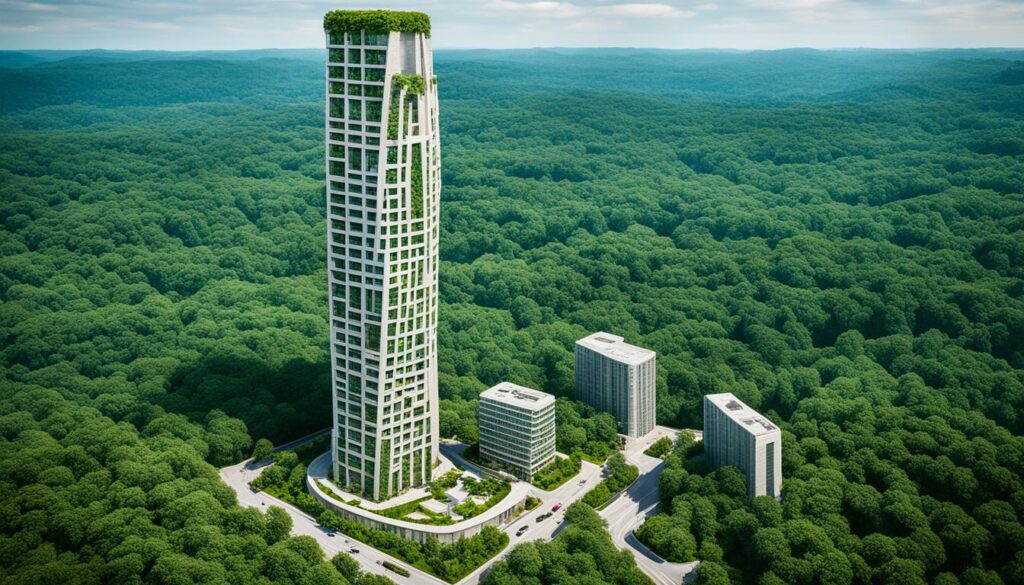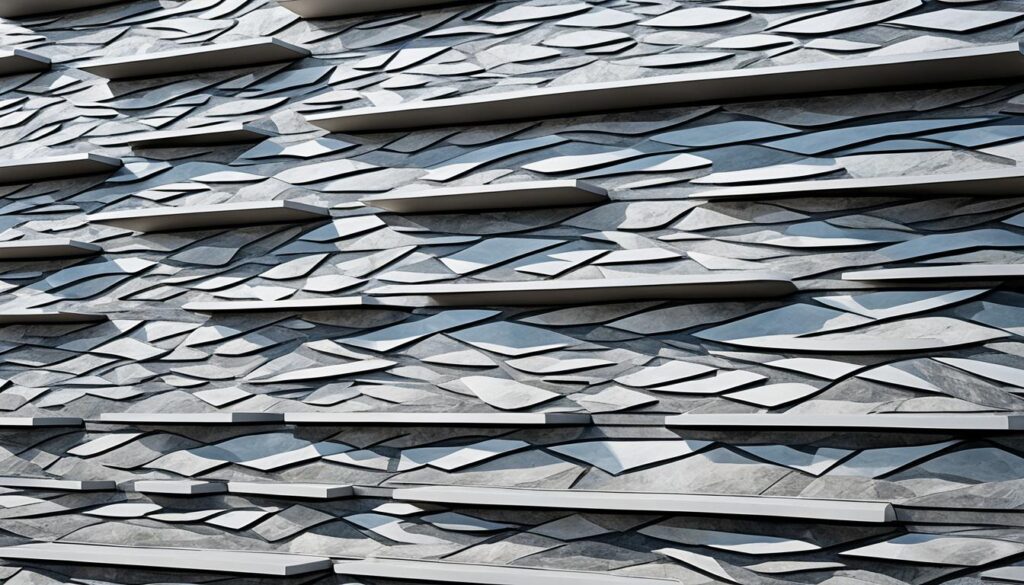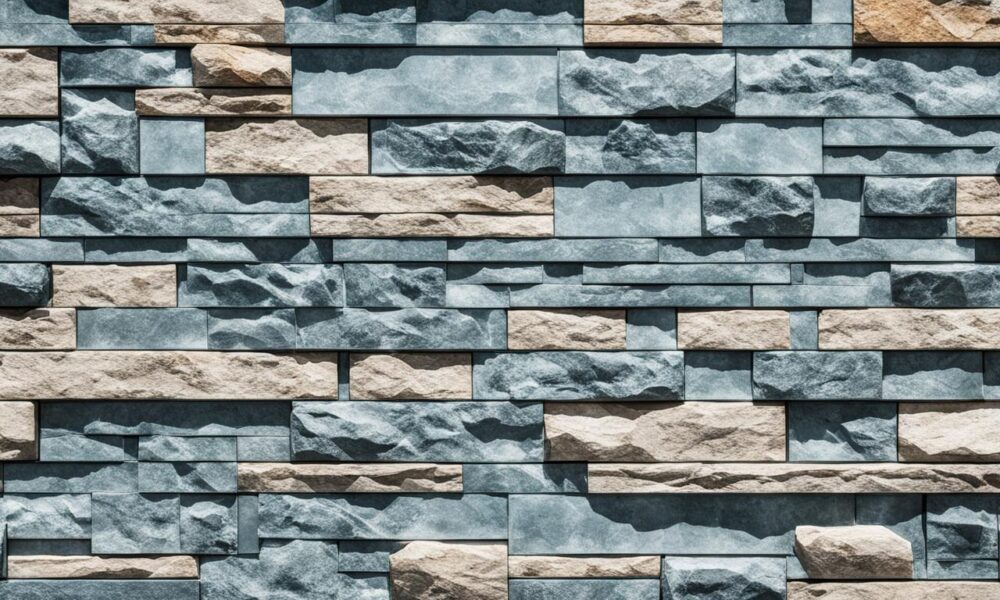Innovative Natural Stone in Modern Architecture Use
For centuries, natural stone has been key in design, going back to the Egyptians, Greeks, and Romans. They used it in big structures like the pyramids and the Colosseum1. Today, this tradition continues in modern buildings. Stone adds beauty and practical benefits1. Features like stone cladding and landscaping elements show its versatility1. Companies like NH Thinstone offer a wide range of natural stone for architects to see and talk about.
Stone is now chosen for its insulation qualities, cutting the need for artificial heating or cooling1. Its low processing and recyclability make stone a green choice1. This makes stone a perfect pick for modern designs that are both sustainable and stunning.
Key Takeaways
- Natural stone has impacted architecture since ancient times1.
- Modern cladding allows for unique building facades1.
- Stone flooring stands up well in busy buildings1.
- Natural stone is good for the environment because it’s recyclable1.
- Using stone for insulation can lower energy use1.
The Timeless Appeal of Natural Stone in Modern Architecture
Natural stone has been a key part of architecture from ancient times to today. Designers and architects love using this strong, beautiful material in new ways. It helps make modern buildings look amazing.
Historical Significance
Think of Egypt’s grand pyramids or the long-lasting buildings of the Roman Empire. Natural stone was crucial in creating these famous wonders. It’s strong and comes in many looks, earning its place in history. It shows why architects have loved natural stone for so long.
Modern Aesthetics
Nowadays, natural stone is getting more popular in new designs because it’s lasting and looks great. The National Kitchen & Bath Association’s 2023 report says homeowners want materials like stone that will last2. Grand View Research thinks the stone market will hit USD 60.2 billion by 2025. This is because of more building projects2.
Stone’s look has changed to fit modern uses, making it great for many uses. It’s seen as good for the planet, attracting those who want to make eco-friendly choices2. Companies like Cupa Stone offer trendy stone products such as Stonepanel, Infercoa, and Granites3. Stonepanel is easy to put up and comes in stones like slate, getting high marks from European groups3.
Milan Design Week 2024, with 270,000 visitors, showed stone’s flexibility in new designs like tubs and stone furniture4. It proves architects around the world love using stone to make spaces beautiful and practical. Taj Mahal quartzite, which is very strong and thin, is perfect for modern furniture4.
Innovative Natural Stone Applications in Modern Architecture
Modern architecture now uses natural stone in new ways. This enhances both its usefulness and beauty. Architects and designers are exploring natural stone for its beauty, quality, and flexibility5. This trend leads to smarter and more eco-friendly building strategies in today’s projects.
Flexible Natural Stones

Flexible natural stones are changing the game. They are light, easy to put up, and work well for big areas and curvy walls5. This breakthrough allows architects to try new design ideas. It makes way for different uses of flexible stones in architecture.
Sustainable Building Practices
Green building with stone is key in modern design. Stone like granite and marble lasts long and can handle different conditions6. Its processing is minimal, and it helps save energy in buildings due to its thermal benefits7. Stone can be reused and recycled, making it a green choice for eco-conscious architects6.
New Cutting-Edge Designs
Natural stone is shaping new designs both inside and outside. Modern buildings use a variety of stone types and finishes for different looks5. Stone can provide extra insulation or add beauty to kitchens and bathrooms6. These innovations highlight natural stone’s increasing role in architectural excellence and creativity56.
Natural Stone Use in Building Facades
Natural stone adds beauty and durability to building facades. It uses limestone, granite, and marble to enhance buildings. Cladding introduces different textures and finishes, beautifying the cityscape. Stone’s durability makes it a wise choice for commercial and residential buildings.
Digital tools like DDL (Digital Dry Layout) are changing how we design with stone8. These tools help in planning and reduce waste. They make it easier for architects, suppliers, and builders to work together8. This shift supports sustainable and efficient building trends.
Natural stone is a low-energy building material. The German Natural Stone Association praises its long-lasting use in architecture9.
Granite and basalt are perfect for exterior walls because they are strong9. Limestone and marble, being softer, are good for indoors9. Using stone from nearby reduces the carbon footprint, making these buildings green8. Stone is a sustainable choice because it’s durable, recyclable, and eco-friendlier than synthetic materials8.

Examples of stone in architecture include Museo Jumex, Giant’s Causeway Centre, and Taunusturm9. These projects show the creative use of stone. Stone facades give architects the chance to design unique buildings. Stone buildings also last a long time, making them a good investment8.
Natural stone in facades is more than just pretty. It’s strong and flexible for architects to use. With modern design leaning towards green and durable options, natural stone remains popular for future projects.
Interior Innovations: Natural Stone in Home have Design
Homes today are embracing natural stone in fresh ways. With influences from the past and present, stone adds timeless charm. The mix of tradition and innovation is striking in modern stone work.
Natural Stone Flooring
Natural stone floors bring nature inside and connect us to history. This choice goes back to ancient times10. It’s tough, has many looks, and suits different tastes. New methods make these floors sustainable and beautiful. They bring texture and character to spaces. Architects and homeowners love stone’s lasting beauty.
Unique Wall Coverings
Natural stone walls turn rooms into art pieces. Imagine black marble with silver, creating luxurious spaces10. These stones have been used in buildings for ages. They still make homes beautiful today.
There are new ways to use stone in walls, like ultra-compact materials that look real10. Architects are exploring new design possibilities with these methods.
Stone Furniture and Decor
Stone also makes furniture and decor stand out. World of Stones USA shows how well-made stone furniture can transform a room1Stone pieces tie a room together and last a long time. They add beauty and a touch of nature. Stone tables and counters continue this blend of nature and history at home.
For more ideas about using natural stone, check out this article for more info.
Sustainable Practices with Natural Be Stone
Natural stone is a top choice for green building. Its benefits make it attractive to architects and builders who care about the environment. They use it in sustainable stone architecture.
Eco-friendly Sourcing
Eco-friendly sourcing is important in the natural stone world. Stones are found all over, reducing shipping emissions. This makes construction greener11. Natural stone also has a smaller carbon footprint than fake materials. It’s better for our planet12. Polycor is proud of its marble certifications in Georgia. Their limestone in Indiana also meets sustainability standards13. Cosentino leads by using renewable energy in its quarries. This shows their commitment to eco-friendly methods11.
Durability and Longevity
Stone lasts a very long time. Some stone buildings have been around for thousands of years. This shows how tough stone is in construction11. Using stone can save money in the long run and doesn’t need much upkeep. It’s an efficient material choice12. The stone industry prefers natural materials because they’re reliable and have little environmental harm13. In the MENA area, many projects use sustainable stone. This is a big step towards greener building practices. Stone engineering has improved, making stone more affordable and creative in construction11.
Here’s a summary of the best certifications and green practices in the field:
| Br Be | Cert Be | Key Pra | Result |
|---|---|---|---|
| Polycor | ANSI/NSC 373 | Clear chain Be y, eco-friendly sour Be, voluntary accredited levels | Sustainability and Be be be |
| Cosentino | – | Using green energy Be quar Be | Less carbon em Beons |
| IMCUBEX | – | Selling eco-aware natural stone products | Supports culture and green sustainability |
Conclusion
Natural stone plays a big part in today’s architecture, showing it’s still very valuable. It is not only used in innovative building projects but also improves the look of homes14. This material is loved for its long life and eco-friendliness, making it a top choice for many architects14.
The return of natural stone in architecture is making waves. Architects now use it in many creative ways to make their designs stand out14. The variety of stones offers different colors, textures, and feels, leading to unique buildings. Thanks to new technology, stone is more available and cost-effective, expected to lead to more groundbreaking designs14.
Natural stone has made a strong comeback thanks to its beauty, strength, and green qualities14. It’s clear it will keep influencing architecture, marrying beauty with green building principles. The ongoing use of natural stone isn’t just about keeping with tradition. It’s also about building a future that values both looks and sustainability.
FAQ
What are some modern architectural stone solutions?
How does natural stone inspire contemporary stone design?
What are the current stone architecture trends?
How has natural stone historically influenced architecture?
What makes natural stone aesthetically valuable in modern architecture?
What are some innovative uses of natural stone in construction?
How does natural stone contribute to sustainable building practices?
What are the benefits of using flexible natural stones in architecture?
Why is natural stone a preferred choice for building facades?
How does natural stone integrate into modern interior design?
What sustainable practices are associated with the use of natural stone?
Source Links
- Uses of Natural Stone in Modern Architecture | NH Thinstone
- Embracing the Stone Age: The Rise of Natural Stone in Modern Design
- Natural Stone Design Trends for 2024 : Authenticity and Sustainability
- MILAN DESIGN WEEK 2024 INSIGHTS: STONE AS A STAPLE IN MODERN DESIGN – Zucchi Luxury Stones
- ▷ Natural Stone in modern architecture designs | L’Antic Colonial
- Modern Architecture: Natural Stones in Design Trends
- Exploring Innovative Stone Applications in Modern Buildings – Natural Stone Sales Limited
- Innovative natural stone applications in modern architecture
- Building with natural stone: aesthetic and versatile
- Natural Stone in Residential Projects and Interiors
- Sustainable Stone: The Building Material of the Past and Future
- Preserving Heritage, Embracing Innovation: The Role of Sustainable Natural Stone in MENA Architecture
- 8 Reasons Why Natural Stone is Sustainable – Polycor Inc.
- The Comeback of Natural Stone in Modern Architecture



